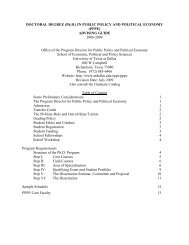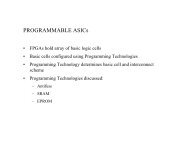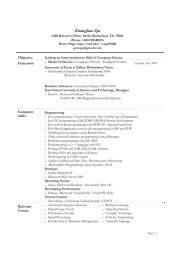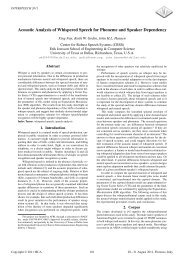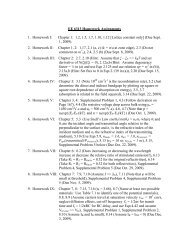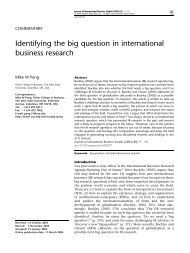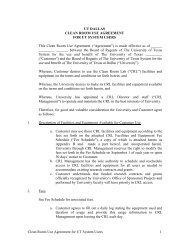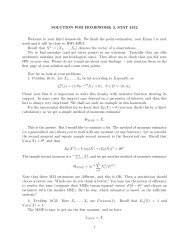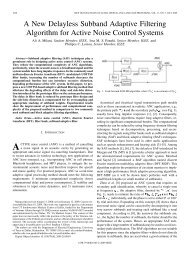Behind Intermediary Performance in Export Trade - The University of ...
Behind Intermediary Performance in Export Trade - The University of ...
Behind Intermediary Performance in Export Trade - The University of ...
You also want an ePaper? Increase the reach of your titles
YUMPU automatically turns print PDFs into web optimized ePapers that Google loves.
INTERMEDIARY PERFORMANCE IN EXPORT TRADE<br />
N 166<br />
(expected sign)<br />
We then employed multiple regression<br />
analyses, which were widely used <strong>in</strong> export<br />
research (Leonidou and Katsikeas,<br />
1996, p. 534). Choos<strong>in</strong>g this route rather<br />
than a causal model<strong>in</strong>g technique such<br />
as LISREL seemed more straightforward<br />
<strong>in</strong> terms <strong>of</strong> results <strong>in</strong>terpretation as well<br />
as more appropriate for the task, given<br />
the exploratory nature <strong>of</strong> this research. 13<br />
FINDINGS<br />
Shown <strong>in</strong> Table 3, Hypothesis 1, the<br />
impact <strong>of</strong> export knowledge on <strong>in</strong>termediary<br />
performance, received strong support.<br />
<strong>The</strong> coefficients were significant for<br />
all dependent variables. Hypothesis 2,<br />
the impact <strong>of</strong> negotiation ability on agent<br />
performance, received mixed support.<br />
When per capita sales was used as the<br />
dependent variable, this hypothesis performed<br />
well, receiv<strong>in</strong>g significant support<br />
( 0.29, p 0.05). However, the<br />
results were not stable when the other<br />
two dependent variables were employed,<br />
whereby no support was found.<br />
TABLE 3<br />
REGRESSION RESULTS<br />
(1) Sales marg<strong>in</strong><br />
(2) Per Capita<br />
Sales<br />
(3) Self-rated<br />
<strong>Performance</strong><br />
t t t<br />
H1. Knowledge () .31 6.58** .19 3.59** .56 4.77***<br />
H2. Negotiation () .25 1.04 .29 2.38* .18 .89<br />
H3. Title () .30 4.47*** .21 5.31*** .67 7.53***<br />
H4. Specialization () .43 3.51*** .31 2.56** .41 5.08***<br />
Size .11 .61 .09 1.04 .05 1.36<br />
Age .20 3.33** .19 .92 .13 .91<br />
Adjusted R 2<br />
.44 .51 .58<br />
F-value 2.26** 4.71*** 6.01***<br />
*p 0.05<br />
**p 0.01<br />
***p 0.001<br />
Hypothesis 3, the impact <strong>of</strong> the ability to<br />
take title to goods, obta<strong>in</strong>ed fairly strong<br />
support. For all three dependent variables,<br />
the coefficients were significant.<br />
F<strong>in</strong>ally, Hypothesis 4, the impact <strong>of</strong> a<br />
commodity products focus on <strong>in</strong>termediary<br />
performance, was strongly supported<br />
on all three occasions.<br />
Overall, the hypotheses performed satisfactorily<br />
<strong>in</strong> all three models, which expla<strong>in</strong>ed<br />
between 44% and 58% <strong>of</strong> the<br />
variance. Both objective performance<br />
measures were correlated with each<br />
other (0.26, p 0.05), but not with the<br />
subjective measure, suggest<strong>in</strong>g that the<br />
objective and subjective measures<br />
tapped <strong>in</strong>to different dimensions <strong>of</strong> performance<br />
(Shoham, 1998; Zou, et al.,<br />
1998). Specifically, per capita sales tends<br />
to have a sales focus, while sales marg<strong>in</strong><br />
focuses on bottom l<strong>in</strong>e pr<strong>of</strong>itability. Subjectively<br />
rated overall performance<br />
could also be tapp<strong>in</strong>g <strong>in</strong>to other dimensions<br />
such as customer satisfaction. This<br />
may help expla<strong>in</strong> why negotiation abil-<br />
338 JOURNAL OF INTERNATIONAL BUSINESS STUDIES



